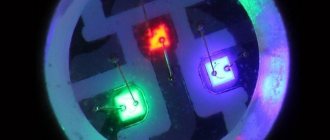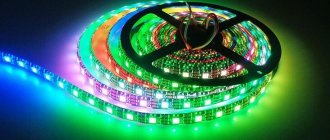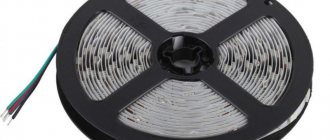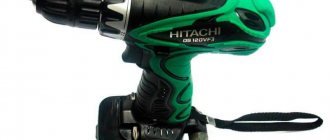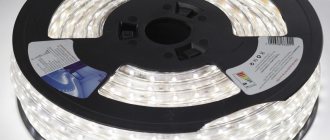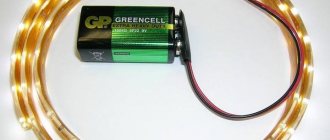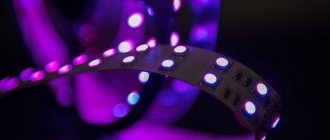Features of independent connection of an LED strip to a 220V network without a power supply. Detailed instructions and types of tapes. +TEST for self-test
TEST:
A little test
- Without a power supply, is the LED strip connected directly to the electrical network?
a) to connect the tape to 220 V, you will need to use a small rectifier, and through it the tape is connected to the outlet.
b) The tape is connected to the network without additional devices.
- Why is it not recommended to buy Chinese models of tapes for connecting to 220 V?
a) Chinese models are assembled from the cheapest materials and manufacturing technologies are not always followed.
b) The buyer may be deceived. Externally, 220 V diodes are very similar to regular ones. Therefore, to ensure that the tape is correct, you will need to check the markings.
- What length of pieces is ICE cut into when selling?
a) 50, 100, 200 cm
b) 30, 80, 140 cm.
- How does the process of connecting a powerful SMD 5630 tape differ from conventional 220 V options?
a) Nothing. The process is similar
b) The energy consumption of this tape is higher than that of conventional ones, so an additional aluminum profile or radiator will have to be connected. This way the assembly will not overheat during operation.
- Why is it not recommended to install 220 V tapes in reading areas?
a) A flicker of 100 hertz is observed. The human eye will not notice this, but a similar effect affects the human consciousness - headaches or fatigue will appear.
b) The light is too strong and will blind the person.
Answers:
- a) To connect the LED to the network without a power supply, you will have to additionally connect a rectifier.
- b) The package may arrive with the wrong model. All tapes are very similar. And in order not to make a mistake, you need to check the markings.
- a) When selling, 220 V tape is cut into pieces of 50, 100 and 200 cm.
- b) Powerful tapes get very hot, and therefore you have to connect a cooling system.
- a) There is flickering coming from the tape. It is invisible to a person, but it still has a negative impact on him.
When the question arises about connecting an LED strip, few people know that there are LEDs designed for 220 V. But in this case, you don’t even need to use a 12 V power supply to connect to the network. Just take a small rectifier, through which the strip will connect directly to the outlet . The advantages of this method include ease of use, as well as ease of connection to the network. But it also has its drawbacks. To understand the nuances, you need to carefully study the material and some of the nuances.
Definition:
LED strips are a light source that spreads through light bulbs. The 220 V sample is used to connect to the mains via a socket.
Varieties of 220 V LED strip
220 V LED strips are divided into several types. They use LEDs:
- 3528.
- 2835.
- 5050.
- 3014.
There are also more powerful samples - SMD 5630. The most popular are 3528 or 5050 tapes. They are quite easy to purchase in Russian stores. But the remaining models will have to be purchased through Internet sites from the Chinese. But professionals do not recommend purchasing such models, since buyers may be deceived. The fact is that outwardly the diodes are very similar to ordinary ones, but they have markings printed on them, indicating the voltage at which the tape can operate.
A design feature is that 220 V tape is cut only one meter or 50 cm long; there is also an option for 200 cm. That is, you won’t be able to get a piece of 80 or 30 cm.
Basic parameters of 220 volt tape
Ice at 220 V has the following parameters:
- Cut into 50, 100 and 200 cm.
- Power watts per meter.
- There is protection against moisture.
- Colorful temperature.
Like any other tapes, this one is available in different modifications depending on the degree of protection against moisture penetration. They use IP 67 and 68. This protection is a durable silicone tube. When using such a sealed tape, it is allowed to install diodes in damp rooms, for example, on the street and in a bathhouse.
If we study consumer reviews, we can conclude that the LED strip is suitable for use in low and high temperature conditions.
The base of the tape is quite rigid, but at the same time flexible. Due to the fact that the LED has a rigid base, a piece of tape is turned into an LED module and a ruler. A lamp is assembled from a similar line.
Installation can be self-adhesive or without an adhesive base.
Why is this necessary?
At first glance, it may seem that there is no need for battery-powered LED strip lighting. But if you think about it, you can find a dozen places in an apartment alone, the lighting of which will increase the level of comfort and add originality. For example,
- inside the wardrobe and wall kitchen cabinets;
- along the contour of shelves and shelves;
- around paintings and mirrors;
- for decorating children's toys and bicycles;
- in the pantry, etc.
In addition, autonomous lighting from an LED strip will be useful in a garage, basement, country house, in general, where there is no stationary 220 V power supply. And in regions where there are frequent power outages, LED lighting can be used as emergency lighting.
Answers to 5 Frequently Asked Questions
- How is the tape powered from a 220 V network?
— LEDs with a normal voltage of 3.3 - 3.5 V are inserted. For them, polar power is used, which provides a diode bridge. If you do not comply with this requirement, the lights will begin to blink. - Why are ribbons cut only into 50, 100 and 200 cm?
— Cut into 50 or 100 mm pieces due to the fact that the light bulbs are connected in series along one circuit. There are 60 LEDs per meter. - How to improve device reliability?
– To increase reliability, use diodes in pairs. As a result, if one fails, current can still pass through the others. - How to connect a powerful SMD 5630 tape?
– Such a tape has a consumption of more than 10 W per meter, so you should additionally connect an aluminum profile or radiator, which serves as a cooling element during operation of the device. - Are 220V lamps available in one color?
– No, there are all the same colors as on regular LEDs.
Using LEDs with a Motion Sensor
This element is integral to the concept of a smart home system. The motion sensor senses the presence of a person or other living creature in the room. Once this happens, the contacts close and the lighting turns on without having to press the switch buttons. The shutdown occurs in a similar way, only in this case the sensor contacts open after no movement is observed in its coverage area for 10 seconds. This is an excellent economical option for those objects that do not require constant illumination.
Nuances of a 220 V device
Greater power is obtained even with weak diodes.
To avoid using two glued pieces side by side, buy double tape. It has a very wide base. And this is even useful - heat will be easier to remove when the diodes are operating.
Double and single tape
LED strips for 220 V are available in the same color options as regular strips.
Colors
When connecting a 220 V RGB strip, you must also install an additional controller that controls the brightness of each color. But they are very difficult to find, so it is advisable to purchase a ready-made kit.
Scheme
To connect the LED strip to the network, you must install the wiring on the rectifier in the correct order in accordance with the polarity.
To do this, you do not need deep knowledge; it is enough to be guided by special diagrams that illustrate the sequence of actions. If electricians connect an LED strip without a block with different diodes, then they are guided by the colors of the wires of the RGB controller.
The LED strip connection diagram shows how to accurately complete each step.
How to avoid 5 mistakes when connecting tape
To avoid connection errors, follow the instructions and take only 5 steps:
- Cut to the required length. Do not forget that you can only cut 50, 100 or 200 cm.
- If the tape is sealed, then the cut ends must be treated with sealant, and then a silicone connector must be put on it. It comes in the form of a ring.
- We connect the convector and secure it with sealant.
- Keep things clear and connect the wire from the rectifier. Rectifier
- We check that the entire tape is as tight as possible. Water should not get inside.
Do-it-yourself power supply for the tape is guaranteed.
The rectifier will consist of a diode bridge with its own power. It can be 700 W. In this case, you can safely use 100 meters of a regular LED strip, or 40 meters of a very powerful one. This is quite enough to illuminate a very large room.
The straightener is quite cheap, but if you don’t want to buy it, you can make it yourself. You will need 4 diodes, or a ready-made assembly in absolutely any store specializing in the sale of radio components.
Unlike conventional LEDs, you do not need to pay attention to the thickness of the power wires. Even if you use a wire of 0.75 square millimeters, it can still handle 1500 W very easily.
Since the device does not have a capacitor, the entire tape will flicker at a frequency of 100 hertz due to the fact that it will not be possible to smooth out the ripples. SanNPIN prohibits the use of such pulsations in work areas or where people read. That is why it is undesirable to install such a device in an apartment.
We connect the diode strip to a 220 V network
Peculiarities
3 volt LEDs wired individually will require multiple components.
At 1-1.5 volts - circuits on one or more transistors for “voltage boost”, so that from this voltage (one nickel-based battery) the device makes 3.2 volts, without which the LED will not light up. For rare LEDs operating at 1.5 volts, such a circuit is not needed.
They operate at a nominal voltage of 1.8-2.2 V, they can be connected directly, in parallel, in any quantities. The more, the more capacious it should be.
If a lithium-ion battery is used, the color LEDs are connected in series pairs. At a maximum voltage of 4.2 V, their glow will reach a level slightly above average (2.1 V per LED). These pairs are connected in parallel to each other. Do not try to connect single colored LEDs in parallel without serial pairing - they will burn out immediately.
Having a power source at hand, for example, an external battery with a 5 V smartphone, neither color nor white LEDs can be connected directly: they will immediately burn out. Here you need an adjustable DC voltage converter - these are produced in China by the millions per year. It’s easy to order the one you need and set the input and output voltages using the tester. The disadvantage of DC-DC converters is low efficiency: losses can be up to 34% depending on the input and output voltage.
12-volt clusters will require not one, but several batteries. For 3 lithium-ion batteries, the voltage ranges from 9 to 12.6 V - the cluster will not be overloaded if you turn on not 3, but 4 LEDs in series (the operating voltage does not exceed 12.8 V). Commercially available industrial assemblies, unfortunately, despite the presence of current-limiting resistors in each cluster, have exactly three rather than four LEDs. Here there is a violation of the correct calculation for the sake of economy: less LEDs are wasted, but they quickly burn out, which forces the consumer to change them regularly. In the case of red ones, for example, for rear side lights (brake light), it would be more correct to connect exactly 6 12 V LEDs (the assembly voltage would be 13.2 V). But savings and the desire for easy super-profits force manufacturers to add not 6, but 5 LEDs to each cluster. When exposed to the voltage of a newly recharged battery, the LEDs overheat and burn out prematurely.
Conclusion: to avoid overloading the LEDs, calculate the circuit parameters carefully. The white LED burns out quickly when the voltage is higher than 3.2 V, the red LED - when the voltage is higher than 2.2. The calculation for nickel or lithium batteries is simple - some produce 1-1.5 V, others - 3-4.2. Try to calculate the circuit so that only one battery cell (one “bank”) works: two or more always wear out unevenly, and overconsumption occurs due to non-use of their resource to the fullest.
Advantages and disadvantages of 220V tape
LEDs designed for connection to a 220 V network have both pros and cons. Having studied these questions, you will be able to decide for yourself where exactly to place such tapes. The choice of place of operation is very important, since a 220 V LED strip is not suitable for every room. The choice of room in the house is very limited due to one significant drawback.
Pros:
- An LED strip is used without a power supply.
- When connecting, a few meters of diodes are simply plugged into the nearest outlet, and they will work.
- The connection is made with any wires, even thin ones, since the current strength through them will be quite low.
- A single assembled piece reaches 100 meters in length. This is very convenient for lighting large areas.
Without power supply
Long ribbon
For outlet
Cons:
- You will have to be especially careful when installing and switching on, as high voltage will be required.
- Light bulbs may soon fail if you purchase low-quality Chinese samples.
- The sealed tape is very difficult to repair - you will have to completely get rid of the sealant, change parts and seal it again.
- There is flicker with a frequency of 100 hertz. The human eye simply won’t notice this, but it will still affect the person’s consciousness - headaches or fatigue will appear.
Due to these shortcomings, the scope of application has to be limited. It is necessary to install 220 V LED strips only in secondary rooms where people do not rest, read or spend a lot of time. For example, LED is used as lighting in the kitchen, pantry or garage; it is very convenient to install a strip to illuminate plants. You can also install lighting on billboards - a street lamp in silicone is not afraid of weather conditions.
Tape in the kitchen
power unit
The most obvious option is to operate the lighting device together with a power supply for the appropriate voltage. Bulky and uneconomical sources, built according to the classical design with a step-down transformer, have long been supplanted from the sphere of LED lighting by light and powerful pulse units. Therefore, the choice of power supply is made mainly according to two parameters:
- output voltage;
- maximum permissible load power.
The first characteristic is selected simply: the voltage must correspond to the voltage of the tape. The second depends on the load and is calculated using the formula Rbp=Rud*L*K , where:
- Ore – power consumed by one meter of web;
- L – total length of tape sections;
- K – safety factor equal to 1.2..1.4.
The result obtained is rounded up to the nearest standard value. If the power supply does not indicate the power, but the maximum permissible current, it can be converted into power using the formula Pbp = Imax * Uout.
Top 2 best manufacturers of 220 V LED strips
In stores specializing in the sale of electrical goods, it is not difficult to find a wide variety of tapes. But not all of them are suitable for connecting to a 220 V power supply. That is why you will have to choose and look for manufacturers who produce the required samples. High-quality companies that have proven themselves in the market:
- Elektrostandart.
- Sveteco.
Companies not only produce 220 V LED strips, but are also distinguished by the good quality of their products.
Buy products from trusted brands, follow the tips and recommendations, do not deviate from the instructions, and then the tape can be connected to a 220 V network without any problems, even for a beginner who has never worked with electricity or lighting before.


